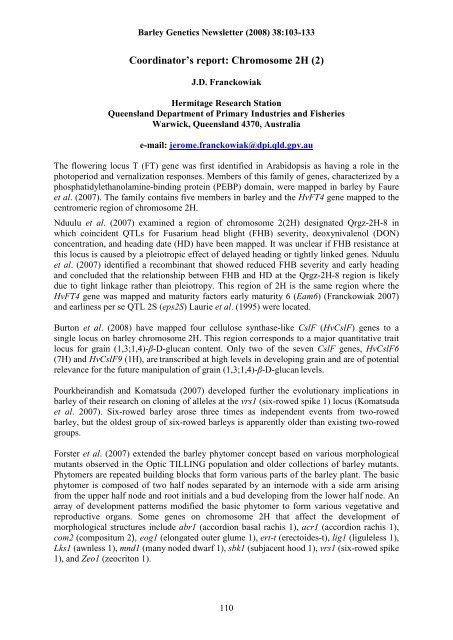BARLEY GENETICS NEWSLETTER - GrainGenes
BARLEY GENETICS NEWSLETTER - GrainGenes
BARLEY GENETICS NEWSLETTER - GrainGenes
You also want an ePaper? Increase the reach of your titles
YUMPU automatically turns print PDFs into web optimized ePapers that Google loves.
Barley Genetics Newsletter (2008) 38:103-133<br />
Coordinator’s report: Chromosome 2H (2)<br />
J.D. Franckowiak<br />
Hermitage Research Station<br />
Queensland Department of Primary Industries and Fisheries<br />
Warwick, Queensland 4370, Australia<br />
e-mail: jerome.franckowiak@dpi.qld.gpv.au<br />
The flowering locus T (FT) gene was first identified in Arabidopsis as having a role in the<br />
photoperiod and vernalization responses. Members of this family of genes, characterized by a<br />
phosphatidylethanolamine-binding protein (PEBP) domain, were mapped in barley by Faure<br />
et al. (2007). The family contains five members in barley and the HvFT4 gene mapped to the<br />
centromeric region of chromosome 2H.<br />
Nduulu et al. (2007) examined a region of chromosome 2(2H) designated Qrgz-2H-8 in<br />
which coincident QTLs for Fusarium head blight (FHB) severity, deoxynivalenol (DON)<br />
concentration, and heading date (HD) have been mapped. It was unclear if FHB resistance at<br />
this locus is caused by a pleiotropic effect of delayed heading or tightly linked genes. Nduulu<br />
et al. (2007) identified a recombinant that showed reduced FHB severity and early heading<br />
and concluded that the relationship between FHB and HD at the Qrgz-2H-8 region is likely<br />
due to tight linkage rather than pleiotropy. This region of 2H is the same region where the<br />
HvFT4 gene was mapped and maturity factors early maturity 6 (Eam6) (Franckowiak 2007)<br />
and earliness per se QTL 2S (eps2S) Laurie et al. (1995) were located.<br />
Burton et al. (2008) have mapped four cellulose synthase-like CslF (HvCslF) genes to a<br />
single locus on barley chromosome 2H. This region corresponds to a major quantitative trait<br />
locus for grain (1,3;1,4)-β-D-glucan content. Only two of the seven CslF genes, HvCslF6<br />
(7H) and HvCslF9 (1H), are transcribed at high levels in developing grain and are of potential<br />
relevance for the future manipulation of grain (1,3;1,4)-β-D-glucan levels.<br />
Pourkheirandish and Komatsuda (2007) developed further the evolutionary implications in<br />
barley of their research on cloning of alleles at the vrs1 (six-rowed spike 1) locus (Komatsuda<br />
et al. 2007). Six-rowed barley arose three times as independent events from two-rowed<br />
barley, but the oldest group of six-rowed barleys is apparently older than existing two-rowed<br />
groups.<br />
Forster et al. (2007) extended the barley phytomer concept based on various morphological<br />
mutants observed in the Optic TILLING population and older collections of barley mutants.<br />
Phytomers are repeated building blocks that form various parts of the barley plant. The basic<br />
phytomer is composed of two half nodes separated by an internode with a side arm arising<br />
from the upper half node and root initials and a bud developing from the lower half node. An<br />
array of development patterns modified the basic phytomer to form various vegetative and<br />
reproductive organs. Some genes on chromosome 2H that affect the development of<br />
morphological structures include abr1 (accordion basal rachis 1), acr1 (accordion rachis 1),<br />
com2 (compositum 2), eog1 (elongated outer glume 1), ert-t (erectoides-t), lig1 (liguleless 1),<br />
Lks1 (awnless 1), mnd1 (many noded dwarf 1), sbk1 (subjacent hood 1), vrs1 (six-rowed spike<br />
1), and Zeo1 (zeocriton 1).<br />
110




